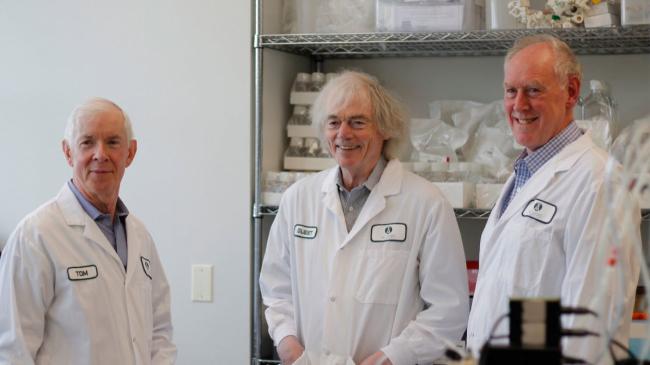UBC Medicine professor Dr. Pieter Cullis helped pave the way for mRNA vaccines and other life-saving treatments thanks to his work on lipid nanoparticles.
As the world continues to emerge from the recent pandemic, over 32 million Canadians have been protected by at least one dose of the COVID-19 vaccine. A majority of those Canadians can thank, in part, the dedicated work of fellow Canadian and UBC professor Dr. Pieter Cullis.
Throughout his 40-year career spanning physics, biochemistry, and molecular biology, Dr. Cullis developed the lipid nanoparticle (LNP) drug delivery platform that is today used in mRNA vaccines, including COVID-19 vaccines, and positively impacting the lives of billions.
Dr. Cullis’ ground-breaking LNP work has been at the heart of many other approved therapies—including delivering anticancer drugs to destroy cancerous tissues while limiting toxicity in healthy ones. When COVID-19 began to spread, these foundational discoveries enabled the rapid development of highly effective mRNA vaccines, fundamentally reshaping the course of the pandemic for the better.
The foundation of COVID-19 mRNA vaccines
The COVID-19 mRNA vaccines are built on a foundation of over three decades of established scientific research, including work carried out by Dr. Cullis, along with Drs. Katalin Karikó and Drew Weissman of the University of Pennsylvania.
Drs. Karikó and Weissman discovered how to engineer mRNA—a molecule that carries instructions for making proteins—so that it could be used to produce a desired protein after introduction into human cells. Despite challenges and skepticism from others in the process, they saw the potential of RNA for vaccines and other applications. However, one major challenge remained: how to introduce the mRNA into the body in a way that would protect it from degradation and allow it to enter cells.
Dr. Cullis’s fundamental discoveries relating to LNP drug delivery provided a solution to this challenge. Lipid nanoparticles were designed to form a protective bubble around the mRNA, enabling its delivery into the target cells. This LNP delivery platform is critical to the potency of mRNA vaccines.
The success of the mRNA vaccines for COVID-19 also suggests a path forward for similar vaccines against other viral threats, including influenza and HIV. Clinical trials are already underway to test mRNA vaccines against infections caused by the Zika, chikungunya and rabies viruses.
Building Canada's biotech sector
The groundwork for the lipid nanoparticle drug delivery technology was laid over 40 years ago when Dr. Cullis, together with Drs. Thomas Madden, Michael Hope, and other UBC colleagues, began developing delivery systems for small-molecule drugs, initially for chemotherapy. In 2009, they launched UBC spin-off company Acuitas Therapeutics—now a highly successful biotech firm that contributed the lipid nanoparticle technology used in the Pfizer/BioNTech COVID-19 vaccine.

Dr. Cullis’ scientific work and entrepreneurial spirit have also helped position Canada as a global leader in next-generation vaccines and therapeutics. Notably, in addition to co-founding two Canadian national centers of excellence networks, he has co-founded 11 biotech companies and two not-for-profit enterprises dedicated to translating academic discoveries into groundbreaking new treatments. He is also a core member of the scientific team for Canada’s Immuno-Engineering and Biomanufacturing Hub (CIEBH), a BC-based and UBC-led research and innovation initiative that aims to accelerate the development and manufacturing of life-saving medicines.
A legacy of recognition, collaboration and mentorship
Dr. Cullis has received many prestigious national and international awards for his work, including the Order of Canada in 2021, the VinFuture Prize (Vietnam), the 2021 Prince Mahidol Award (Thailand), the 2022 Gairdner International Award (Canada), the 2022 Tang Prize (Taiwan), the 2022 Governor General’s Innovation Award (Canada), the 2023 NRC Killam Prize and is will be a 2024 inductee into the Canadian Medical Hall of Fame (Canada).
Over the course of his career, Dr. Cullis has also trained thousands of scientists. His tireless commitment to mentorship has inspired countless future innovators and has left an indelible mark on the country’s next generation of medical and scientific leaders.
“Great research is a collective effort,” says Dr. Cullis, speaking on the achievements of the LNP delivery technology and the COVID-19 vaccines. “I would be remiss if I did not acknowledge the efforts of literally hundreds of people who have helped make the COVID-19 mRNA vaccines possible. To have been part of this story is truly unbelievable and is a great example of how basic research is so essential to achieving new medicines that change the world.”
Recent Awards
- Canadian Medical Hall of Fame (2024 inductee)
- Fellow of the Royal Society (2023)
- Member of the Order of British Columbia (2023)
- Killam Prize for Health Sciences (2023)
- Bloom Burton Award (2022)
- Governor General’s Innovation Award (2022)
- Gairdner International Award (2022)
- Officer of the Order of Canada (2022)
- VinFuture Foundation’s Sci-Tech Award (2022)
- Prince Mahidol Award (2022)
- Tang Prize in Biopharmaceutical Sciences (2022)
- Controlled Release Society Founders Award (2021)
- Fellow National Academy of Inventors (2018)
- Journal of Drug Targeting Lifetime Achievement Award (2016)
- Life Science BC Milton Wong Leadership Award (2015)
- Prix Galien Canada Research Award (2011)
